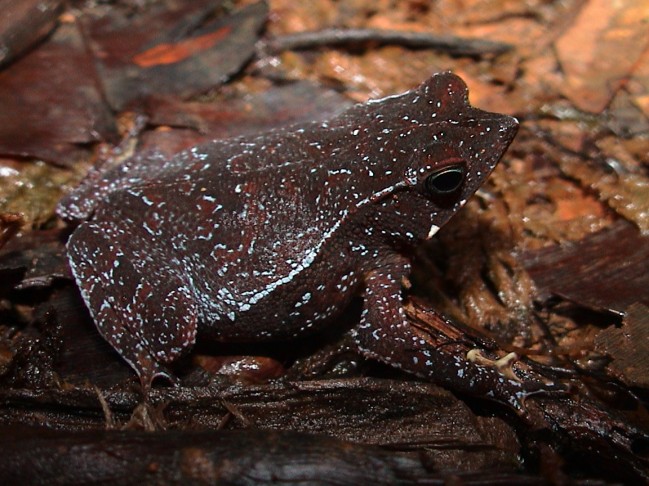Herpetology
Amphibians
The class Amphibians is, at present, probably one of the most threatened groups worldwide. Its greatest threats include global climate change, pollution and emerging diseases. Identifying necessities for their conservation is, of course, a priority.
This involves the acquisition of knowledge on the biology and ecology of the species through regular monitoring of population status. The high richness of amphibians in the reserve and, more generally, in French Guiana make this part of the world’s number one hotspots for conservation of amphibians.
Monitoring Dendrobates tinctorius
This is an iconic looking and determining species in Guyana. The colour pattern, as well as its ecology (diurnal and terrestrial species), makes Dendrobates tinctorius a good subject for study and the monitoring of populations. The data collected each year provide a trend of the population in the reserve. This monitoring will be linked back to the chitridiomycosis surveys (see below).
Similar studies are being undertaken in other nature reserves in French Guiana. The data of Trésor can therefore be analysed relative to the scale of French Guiana.
The method used is called capture-mark-recapture and takes place on the botanical trail. The colour patterns of Dendrobates are unique to each specimen and are therefore helpful for individual recognition. Pictures of the back and sides are made during each capture to enable subsequent identification. Late in the study, the proportion of recaptures during follow-ups, compared to the number of total catches, provide information on the population trends of the study area.
The operation, initiated in 2009, is repeated every year at the beginning of the rainy season in order to detect eventual fluctuations in time and ensure retention in the long term.
Observation of common species
Parallel to the Dendrobates study on the botanical trail, all encounters of common frog species are noted. This counts not only for visual contacts, but also for the observation of species specific songs. This study includes two kinds of leaf toads (Rhinella margaritifera and R. castaneotica), the Cayenne stubfood toad (Atelopus flavescens) and the Aromobatids Anomaloglossus baeobatrachus and Allobates femoralis.
This study concerns only an estimation of abundancy; no individuals are examined.
Chytrid study
The fungus Batrachochytrium is known to parasitise on the skin of amphibians, causing chytridiomycosis, an infectious disease responsible for the decimation of populations of different amphibian species all around the world.
A sampling survey conducted in 2012 has shown the prevalence (percentage of contamination) of the pathogen in Atelopus franciscus, Rhinella spp. and Dendrobates tinctorius in French Guiana and the territory of the Trésor reserve.
If the identity and virulence of the French Guianese strain remain unknown for the moment, regular (annual) sampling in these species can be able to show changes in the level of contamination. The review of the general state of the specimens is an integral part of the protocol.
This study is coupled with demographic monitoring of the population of Dendrobates tinctorius on the botanical trail. It is planned to extend the sampling of species appearing to be in decline on the reservation or more prone to risk (riparian species).
Sterile swabs are rubbed directly on the skin of amphibians insisting well on the front and rear legs (keratin rich parts are targeted by the fungus).
Particular attention will be paid to individuals found weakened and/or damaged. Detection of fungal pathogen subsequently happens in the laboratory.
At present, we have too little information to suggest a trend, but it does not seem to attend mass extinctions as observed in other countries.



